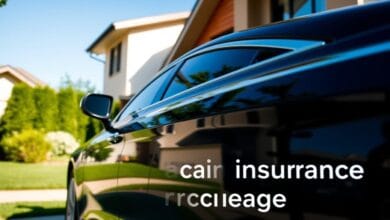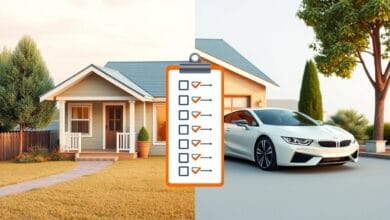What to Do After a Car Accident: Insurance Claims Process Explained

Being in a car accident can be very stressful. It’s important to know how to protect yourself and get the help you need from your insurance. This guide will help you understand what to do after an accident. We’ll cover everything from your insurance coverage to the claims process.
Key Takeaways
- Understand your car insurance coverage, including liability, collision, and comprehensive protection.
- Report the accident to your insurance company promptly and gather all necessary documentation.
- Work closely with the insurance adjuster to file your claim and ensure a smooth repair process.
- Be aware of your deductibles and out-of-pocket expenses related to the accident.
- Explore options for rental car coverage and choosing a reputable repair shop.
Understanding Your Car Insurance Coverage
Protecting your vehicle and yourself in an accident is key. Knowing about liability, collision, and comprehensive coverage is important. These coverages help in different ways.
Liability Coverage
Liability coverage is the most basic. It protects you if you’re at fault in an accident. It covers the other party’s medical and repair costs.
Collision Insurance
Collision insurance helps fix your car if you crash into something. It’s great for newer or valuable cars. It saves you money on repairs.
Liability coverage is needed in most states. But, collision is optional. If you’re financing your car, you might need collision coverage.
Comprehensive coverage protects against non-collision damage. This includes theft, vandalism, or natural disasters. It’s good for areas with bad weather or high theft rates.
Knowing about car insurance types helps you choose the right coverage. Review your coverage often. This keeps you safe and prepared on the road.
Reporting the Accident to Your Insurance Company
When you’re in a car accident, the first thing to do is tell your insurance company right away. This starts the claims process and keeps your coverage in place. Quick action helps make the process smoother and increases your chances of a good outcome.
To report the accident, you’ll need to give some basic information:
- Date, time, and location of the accident
- Details of the other vehicle(s) and driver(s) involved
- A description of the accident and any injuries or damages
- Your policy number and contact information
Your insurance company will then help you with the next steps. This might include filing a police report, getting your car checked, and working with a claims adjuster. By being quick and giving all the details, you make the process easier.
It’s important to report the accident to your insurance provider right away. It’s not just smart; it might be required by your policy. Not doing so could risk your coverage or slow down the claims process. So, make that call and start your claims process, policy renewals, and insurance quotes journey.
“The sooner you report the accident, the sooner your insurance company can begin the claims process and help you get back on the road.”
Gathering Essential Information
After a car accident, it’s key to collect as much information as you can. This info is crucial for your insurance claim and any legal actions. Let’s look at how to document the accident scene and exchange contact and insurance details effectively.
Documenting the Accident Scene
Take detailed notes and photos of the accident scene. Note the location, time, and date of the incident. Also, capture images of the vehicle damage, any injuries, and the scene itself. These photos will help support your insurance claim.
- Jot down the exact location, including street names, intersections, and landmarks.
- Note the time and date of the accident.
- Photograph the damage to your vehicle, as well as any injuries sustained.
- If possible, capture images of the other vehicle(s) involved and the overall accident scene.
Exchanging Contact and Insurance Details
It’s vital to exchange contact and insurance info with the other driver(s). This info is needed for your insurance claim and any legal actions.
- Obtain the name, phone number, and driver’s license information of the other driver(s).
- Ask for the make, model, and license plate number of the other vehicle(s).
- Exchange insurance details, including the policy numbers and the name of the insurance provider.
- If the police are involved, obtain a copy of the accident report for your records.
Collecting this information ensures you have a detailed record of the accident. This is important for filing your insurance claim. Remember, deductibles, premiums, and discounts may be affected, so thorough documentation is crucial.
Car & Auto Insurance: Filing a Claim
Filing a claim for car and auto insurance is key to protecting your money. Knowing how to handle deductibles and out-of-pocket costs helps you make smart choices. This way, you get the coverage you need.
Deductibles and Out-of-Pocket Expenses
When you file a claim, the deductible is a big deal. It’s the amount you pay before your insurance helps. Deductibles can be from $250 to $1,000 or more. A higher deductible means lower premiums but more costs for you.
You might also have to pay for things not covered by your insurance. This could be rental car fees, towing, or other costs. Knowing these out-of-pocket costs helps you plan your budget.
Look for discounts or ways to save money from your insurance company. Some offer deductible waivers or help with the claims process to lower your costs.
| Deductible Amount | Impact on Premiums | Out-of-Pocket Expenses |
|---|---|---|
| $250 | Higher monthly premiums | Lower out-of-pocket costs |
| $500 | Moderate monthly premiums | Moderate out-of-pocket costs |
| $1,000 | Lower monthly premiums | Higher out-of-pocket costs |
Understanding deductibles and out-of-pocket costs makes filing a claim easier. You’ll know how to get the coverage you deserve.
Working with the Insurance Adjuster
When you’re dealing with the claims process, it’s key to talk well with the insurance adjuster. They are important in checking your accident details and figuring out what coverage and money you should get.
Here are some important things to remember when working with the adjuster:
- Be ready to give a full story of the accident, including any important papers or proof.
- Know the adjuster’s job in looking at your policy renewals and figuring out your claim’s value.
- Speak up for yourself, but also be willing to talk and find a fair deal.
- Ask for clarity on any parts of the insurance quotes or settlement that you don’t get.
- Keep talking openly and honestly to build trust and get your claim settled quickly.
By working closely with the insurance adjuster and understanding their view, you can go through the claims process with confidence. This way, you make sure your side is heard and taken care of.
| Key Considerations When Working with the Insurance Adjuster | Description |
|---|---|
| Provide Detailed Information | Be ready to share a full story of the accident, including any important papers or proof. |
| Understand the Adjuster’s Role | The adjuster checks your claim details and decides on the right coverage and money. |
| Advocate for Your Interests | Clearly share your view and needs, but also be open to finding a fair deal. |
| Ask Questions and Clarify | Don’t be shy to ask for clearness on any unclear parts of the insurance quotes or settlement. |
| Maintain Open Communication | Good, open talk can help build trust and speed up settling your claim. |
By knowing the adjuster’s role and working well with them, you can go through the claims process with confidence. This ensures your side is heard and taken care of.
Navigating the Repair Process
Dealing with a car accident’s aftermath can be tough. But, you don’t have to let it overwhelm you. By knowing your options and taking action, you can get your car fixed quickly and without breaking the bank.
Choosing a Repair Shop
Finding the right repair shop is key. Look for shops certified by your insurance. This makes the process smoother and ensures quality work. Also, check the shop’s reputation, customer feedback, and the techs’ experience.
Understanding Rental Car Coverage
Most car insurance policies offer rental car coverage. This is a big help while your car is being fixed. Check your policy to know the details, like daily limits and any costs you might face. This helps you plan and budget for any extra expenses.
FAQ
What is liability coverage?
Liability coverage helps if you’re at fault in an accident. It pays for the other driver’s medical bills and car damage. Your policy sets a limit for these costs.
What is collision insurance?
Collision insurance covers your car if you crash into something. It pays for repairs or a new car, no matter who’s at fault.
What is comprehensive coverage?
Comprehensive coverage protects your car from theft, vandalism, and natural disasters. It helps avoid expensive repairs or replacements.
What is a deductible?
A deductible is the amount you pay before insurance kicks in. For example, if your repair costs $2,000 and your deductible is $500, you pay $500. Your insurance covers the rest.
How can I lower my car insurance premiums?
To lower your premiums, consider these options: – Raise your deductible – Use available discounts – Drive safely – Adjust your coverage – Shop around for better quotes
What should I do if I’m involved in a car accident?
First, make sure everyone is safe and call the police. Then, collect the other driver’s info and any witness statements. Report the accident to your insurance and start the claims process.
How long does the car insurance claims process typically take?
The time it takes varies by case complexity and damage extent. It usually takes a few days to weeks. Stay in touch with your insurance for a smooth process.
Can I choose my own repair shop for my vehicle?
Yes, you can usually choose your repair shop. But, some insurers have preferred shops. Talk to your insurance to understand their policies.
What should I do if I’m not satisfied with the repair work on my vehicle?
If you’re unhappy with repairs, talk to the shop first. They might fix the issues. If not, tell your insurance. They can help resolve the problem.


